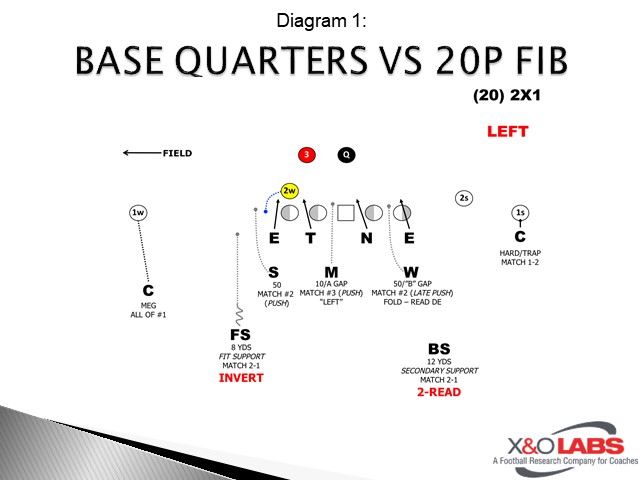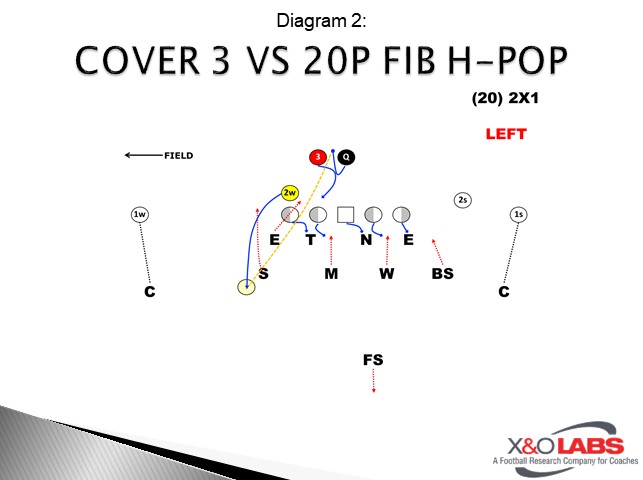By Cody Alexander
Secondary Coach
Midlothian High School (TX)
Twitter: @The_Coach_A
Though it may seem counter intuitive, utilizing reduced space can get a defense to over react to WRs into the boundary. As I wrote in my first book, Cautious Aggression: Defending Modern Football, offensive coordinators align formations into the boundary to get the defense to over rotate to the short side of the field, baiting the defense to leave the wide side without an overhang. Offensive coordinators also use FIB to take advantage of how a defense sets its strength, and finally, to isolate a single WR on a CB. Add the use of quick motions back to the field and the defense can look as though it is ill prepared for what seems like an easy transition. The goal of this report is to demonstrate how Quarters, and primarily a two-high scheme gives the defense the best chance at combating FIB formations.
Most Quarters schemes can function as a split-field defense. This means that each side of the secondary can react to the set, or number of WRs it is given, and can be manipulated by the coach to fit any need by the defense. By running a split-field look, the defense has a better chance of reacting to an offense that puts a formation into the boundary (FIB). The diagram below illustrates this flexibility.
Defending 20 Personnel Y Off FIB:
To the two WR side, the secondary is in a 2-Read, or match Cover 2 concept. This allows the CB to be “hard” (aggressive) near the line to combat a vertical by #1, an RPO screen into the boundary, or as a plus-one if the ball comes back to the short side. This added value by the CB forces the offense to go back to the field, making them predictable. Playing 2-Read over the two WRs also allows the Will LB to work back into the box since he knows the CB will take any out cut by #2. In the diagram, the Will is labeled as “late push.” The coaching point for the Will is to step to his gap with his 6” steps (lead leg first) and read the mesh. If the RB comes his way, fold or fit off the DE, if the QB pops up to pass, the Will holds the curl, working through #2 to get to #1. If #2 goes out, the Will’s eyes dart to #1 to see if he is coming back inside, holding the curl and bracketing the WR with the safety.

The field side is just as crucial to the boundary. In a Quarters scheme, especially to the single WR side. The advantage of staying two-high and running split-field scheme is that a defensive coach can manipulate either side to fit what is needed. In an obvious passing situation, the field safety (FS) would not invert down on the open side (shown above), instead opting to stay high and assist the field CB in the pass, primarily in what I refer to as the “post-hole” (the area near/on the hash where most Posts are thrown). The safety’s alignment to the field should be near or on the hash depending on tendency of the offense.
Many coaches will spin a safety down prior to the snap to gain leverage on the sniffer or H-back. By putting the safety to the boundary down prior to the snap, a defensive coach is opening the door for the offense to use play-action against his defense. Below is a diagram of a typical “H-Pop” spread offenses use to counter aggressive Cover 3 or single-high schemes. Staying in a two-high shell inhibits the ability of the offense to gain free access to the field and keeps them cornered into the boundary. The eyes of the safety to the open side should read through the sniffer to the QB to see the play develop. Versus a pass the safety either takes the vertical stem of the H-back or works to the “post-hole” with eyes back to #1.

One of the most basic ways that an offense can attack a defense by using formation into the boundary is from a 20 personnel or Y-Off formation. In the clip, below, the offense puts both WRs into the boundary while setting both backs to the field. If the defense were to roll to the boundary, the defense would lose the field overhang. The play shown is the infamous Power Toss, made famous by Chad Morris at Clemson. The fits for the defense are simple, the DE to the play side will work to his first threat or QB because he has that in option responsibility. The Sam should fit outside the arcing sniffer to force a cutback but makes the mistake of going inside the arc. Not all is lost, because the inverting safety is there to correct him and make a tackle for a loss.








